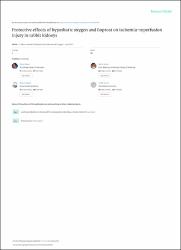| dc.contributor.author | İlhan, Gökhan | |
| dc.contributor.author | Aksun, Murat | |
| dc.contributor.author | Bozok, Şahin | |
| dc.contributor.author | Özpak, Berkan | |
| dc.contributor.author | Güneş, Tevfik | |
| dc.contributor.author | Durakoğlugil, Murtaza Emre | |
| dc.contributor.author | Kara, Hüsnü | |
| dc.contributor.author | Küpeli, Ali | |
| dc.contributor.author | Şener, Erol | |
| dc.date.accessioned | 2020-12-19T20:04:25Z | |
| dc.date.available | 2020-12-19T20:04:25Z | |
| dc.date.issued | 2013 | |
| dc.identifier.citation | Ilhan, G., Aksun, M., Bozok, S., Ozpak, H.B., Gunes, T., Durakoglugil, M.E., Kara, H. ve diğerleri (2013). Protective effects of hyperbaric oxygen and iloprost on ischemia-reperfusion injury in rabbit kidneys. Italian Journal of Vascular and Endovascular Surgery, 20(2), 89-95. | en_US |
| dc.identifier.issn | 1824-4777 | |
| dc.identifier.uri | https://hdl.handle.net/11436/3325 | |
| dc.description | Bozok, Sahin/0000-0002-1256-5055; DURAKOGLUGIL, MURTAZA EMRE/0000-0001-5268-4262 | en_US |
| dc.description | WOS: 000322943900006 | en_US |
| dc.description.abstract | Aim. the aim of the study was to demonstrate protective effects of hyperbaric oxygen (HBO) and iloprost (IL) on renal ischemia-reperfusion (IR) injury using histopathological and biochemical methods. Methods. Fourty New Zealand white male rabbits were randomly allocated into one of four study groups. HBO group (N.=10) received a single session of HBO treatment (120 min at 2.5 atm); IL group (N.=10) received an infusion of 25 ng/kg/min IL; HBO+IL group (N.=10) received both HBO and IL; control group (N.=10) received only 0.9% saline. Renal ischemia-reperfusion was established by clamping abdominal aorta for 1h. Levels of pH, PO2, PCO2, HCO3, Na+, K+, lactate dehydrogenase, blood urea nitrogen and creatinine, plasma and renal malondialdehyde, myeloperoxidase, glutathione and superoxide dismutase were measured at onset, the end of ischemia period and the 24th hour of reperfusion. the kidneys of the sacrificed rabbits were evaluated histopathologically. Results. Even though blood urea nitrogen and creatinine levels were significantly higher in control group, there were not any differences between other groups. Blood PO2, pH, and HCO3 concentrations were significantly elevated and malondialdehyde levels were lower in control group compared to HBO, IL and BBO+IL groups. Histopathological changes including tubular necrosis, atrophy, hydropic degeneration and regenerative atypia that reflect renal injury were also significantly higher in control group. Conclusion. We suggested that both HBO and IL, either alone or in combination significantly reduced biochemical and histopathological signs of renal ischemia-reperfusion injury. | en_US |
| dc.language.iso | eng | en_US |
| dc.publisher | Edizioni Minerva Medica | en_US |
| dc.rights | info:eu-repo/semantics/openAccess | en_US |
| dc.subject | Reperfusion injury | en_US |
| dc.subject | Hyperbaric oxygenaytion | en_US |
| dc.subject | Iloprost | en_US |
| dc.title | Protective effects of hyperbaric oxygen and iloprost on ischemia-reperfusion injury in rabbit kidneys | en_US |
| dc.type | article | en_US |
| dc.contributor.department | RTEÜ, Tıp Fakültesi, Cerrahi Tıp Bilimleri Bölümü | en_US |
| dc.contributor.institutionauthor | İlhan, Gökhan | |
| dc.contributor.institutionauthor | Bozok, Şahin | |
| dc.contributor.institutionauthor | Durakoğlugil, Murtaza Emre | |
| dc.identifier.volume | 20 | en_US |
| dc.identifier.issue | 2 | en_US |
| dc.identifier.startpage | 89 | en_US |
| dc.identifier.endpage | 95 | en_US |
| dc.relation.journal | Italian Journal of Vascular and Endovascular Surgery | en_US |
| dc.relation.publicationcategory | Makale - Uluslararası Hakemli Dergi - Kurum Öğretim Elemanı | en_US |


















